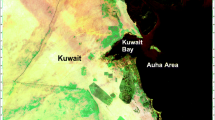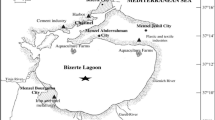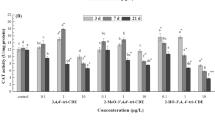Abstract
The present study investigates the response of three hepatic biomarkers in adult sea bass (Dicentrarchus labrax, Linnaeus 1758) caged at a wastewater outlet of an oil refinery with fish caged at a pristine site used as controls. The biomarkers that were investigated were the hepatosomatic index (HSI), 7-ethoxyresorufin-O-deethylase (EROD) activity and glutathione-S-transferase (GST) activity. In addition, we have measured the levels of polycyclic aromatic hydrocarbons (PAHs) and selected heavy metals (lead, cadmium, mercury, copper and zinc) in sediment samples at the polluted site. Although the polluted site had high environmental levels of PAHs and heavy metals, there was no difference in hepatic EROD activity and HSI between fish caged at the polluted site and controls. On the other hand, GST activity was significantly lower in fish caged at the polluted site compared to controls. Our results point out that the studied biomarkers have limited use in environmental risk assessment studies, at least when caged adult sea bass is used as the sentinel species and complex toxicant mixtures are involved.



Similar content being viewed by others
References
Abrahamson, A., Andersson, C., Jönsson, M. E., Fogelberg, O., Örberg, J., Brunström, B., et al. (2007). Gill EROD in monitoring of CYP1A inducers in fish—a study in rainbow trout (Oncorhynchus mykiss) caged in Stockholm and Uppsala waters. Aquatic Toxicology, 85(1), 1–8.
Alebić-Juretić, A. (1994). Polycyclic aromatic hydrocarbons in the urban atmosphere of Rijeka (Croatia). Fresenius Environmental Bulletin, 3(2), 89–94.
Almeida, J. R., Gravato, C., & Guilhermino, L. (2012). Biological parameters towards polycyclic aromatic hydrocarbons pollution: a study with Dicentrarchus labrax L. exposed to the model compound benzo(a)pyrene. Water, Air, and Soil Pollution, 223(8), 4709–4722.
Beijer, K., Gao, K., Jönsson, M. E., Larsson, D. G. J., Brunström, B., & Brandt, I. (2013). Effluent from drug manufacturing affects cytochrome P450 1 regulation and function in fish. Chemosphere, 90(3), 1149–1157.
Ben Ameur, W., de Lapuente, J., El Megdiche, Y., Barhoumi, B., Trabelsi, S., Camps, L., et al. (2012). Oxidative stress, genotoxicity and histopathology biomarker responses in mullet (Mugil cephalus) and sea bass (Dicentrarchus labrax) liver from Bizerte Lagoon (Tunisia). Marine Pollution Bulletin, 64(2), 241–251.
Bihari, N., Fafanđel, M., Hamer, B., & Kralj-Bilen, B. (2006). PAH content, toxicity and genotoxicity of coastal marine sediments from the Rovinj area, Northern Adriatic, Croatia. Science of the Total Environment, 366(2–3), 602–611.
Bihari, N., Fafanđel, M., & Piškur, V. (2007). Polycyclic aromatic hydrocarbons and ecotoxicological characterization of seawater, sediment, and mussel Mytilus galloprovincialis from the Gulf of Rijeka, the Adriatic Sea, Croatia. Archives of Environmental Contamination and Toxicology, 52(3), 379–387.
Brüschweiler, B. J., Würgler, F. E., & Fent, K. (1996). Inhibitory effects of heavy metals on cytochrome P4501A induction in permanent fish hepatoma cells. Archives of Environmental Contamination and Toxicology, 31(4), 475–482.
Burke, M. D., & Mayer, R. T. (1974). Ethoxyresorufin: direct fluorimetric assay of a microsomal O dealkylation which is preferentially inducible by 3-methylcholanthrene. Drug Metabolism and Disposition, 2(6), 583–588.
Collier, T. K., Singh, S. V., Awasthi, Y. C., & Varanasi, U. (1992). Hepatic xenobiotic metabolizing enzymes in two species of benthic fish showing different prevalences of contaminant-associated liver neoplasms. Toxicology and Applied Pharmacology, 113(2), 319–324.
Cotou, E., Henry, M., Zeri, C., Rigos, G., Torreblanca, A., & Catsiki, V. A. (2012). Short-term exposure of the European sea bass Dicentrarchus labrax to copper-based antifouling treated nets: copper bioavailability and biomarkers responses. Chemosphere, 89(9), 1091–1097.
Dupuy, C., Couillard, C. M., Laroche, J., Nellis, P., Brousseau, P., & Fournier, M. (2012). A multibiomarker approach on the Atlantic tomcod (Microgadus tomcod) in the St. Lawrence Estuary. Environmental Science and Pollution Research, 1–12
Fattore, E., Benfenati, E., Mariani, G., Cools, E., Vezzoli, G., & Fanelli, R. (1997). Analysis of organic micropollutants in sediment samples of the Venice Lagoon, Italy. Water, Air, and Soil Pollution, 99(1–4), 237–244.
Forbes, V. E., Palmqvist, A., & Bach, L. (2006). The use and misuse of biomarkers in ecotoxicology. Environmental Toxicology and Chemistry, 25(1), 272–280.
Habig, W. H., Pabst, M. J., & Jakoby, W. B. (1974). Glutathione S-transferases. The first enzymatic step in mercapturic acid formation. Journal of Biological Chemistry, 249(22), 7130–7139.
Hanson, N., & Larsson, Å. (2011). Biomarker analyses in caged and wild fish suggest exposure to pollutants in an urban area with a landfill. Environmental Toxicology, 26(3), 315–324.
Islam, M. S., & Tanaka, M. (2004). Impacts of pollution on coastal and marine ecosystems including coastal and marine fisheries and approach for management: a review and synthesis. Marine Pollution Bulletin, 48(7–8), 624–649.
Kantoniemi, A., Vähäkangas, K., & Oikari, A. (1996). The capacity of liver microsomes to form benzo[a]pyrene-diolepoxide-DNA adducts and induction of cytochrome P450 1A in feral fish exposed to pulp mill effluents. Ecotoxicology and Environmental Safety, 35(2), 136–141.
Kerambrun, E., Sanchez, W., Henry, F., & Amara, R. (2011). Are biochemical biomarker responses related to physiological performance of juvenile sea bass (Dicentrarchus labrax) and turbot (Scophthalmus maximus) caged in a polluted harbour? Comparative Biochemistry and Physiology - C Toxicology and Pharmacology, 154(3), 187–195.
Kerambrun, E., Henry, F., Courcot, L., Gevaert, F., & Amara, R. (2012a). Biological responses of caged juvenile sea bass (Dicentrarchus labrax) and turbot (Scophtalmus maximus) in a polluted harbour. Ecological Indicators, 19, 161–171.
Kerambrun, E., Le Floch, S., Sanchez, W., Thomas Guyon, H., Meziane, T., Henry, F., et al. (2012b). Responses of juvenile sea bass, Dicentrarchus labrax, exposed to acute concentrations of crude oil, as assessed by molecular and physiological biomarkers. Chemosphere, 87(7), 692–702.
Krča, S., Žaja, R., Čalić, V., Terzić, S., Grubešić, M. S., Ahel, M., et al. (2007). Hepatic biomarker responses to organic contaminants in feral chub (Leuciscus cephalus)—laboratory characterization and field study in the Sava River, Croatia. Environmental Toxicology and Chemistry, 26(12), 2620–2633.
Long, E. R., Macdonald, D. D., Smith, S. L., & Calder, F. D. (1995). Incidence of adverse biological effects within ranges of chemical concentrations in marine and estuarine sediments. Environmental Management, 19(1), 81–97.
Lowry, O. H., Rosebrough, N. J., Farr, A. L., & Randall, R. J. (1951). Protein measurement with the Folin phenol reagent. The Journal of Biological Chemistry, 193(1), 265–275.
Martín-Díaz, M. L., Villena-Lincoln, A., Bamber, S., Blasco, J., & DelValls, T. Á. (2005). An integrated approach using bioaccumulation and biomarker measurements in female shore crab, Carcinus maenas. Chemosphere, 58(5), 615–626.
Sanchez, W., Piccini, B., Ditche, J. M., & Porcher, J. M. (2008). Assessment of seasonal variability of biomarkers in three-spined stickleback (Gasterosteus aculeatus L.) from a low contaminated stream: implication for environmental biomonitoring. Environment International, 34(6), 791–798.
Stien, X., Percic, P., Gnassia-Barelli, M., Roméo, M., & Lafaurie, M. (1998). Evaluation of biomarkers in caged fishes and mussels to assess the quality of waters in a bay of the NW Mediterranean Sea. Environmental Pollution, 99(3), 339–345.
Traven, L., Žaja, R., Lončar, J., Smital, T., & Mićović, V. (2008). CYP1A induction potential and the concentration of priority pollutants in marine sediment samples—in vitro evaluation using the PLHC-1 fish hepatoma cell line. Toxicology in Vitro, 22(6), 1648–1656.
Vakharia, D. D., Liu, N., Pause, R., Fasco, M., Bessette, E., Zhang, Q. Y., et al. (2001). Polycyclic aromatic hydrocarbon/metal mixtures: effect on PAH induction of CYP1A1 in human HEPG2 cells. Drug Metabolism and Disposition, 29(7), 999–1006.
Valdehita, A., Fernández-Cruz, M. L., Torrent, F., Sericano, J. L., & Navas, J. M. (2012). Differences in the induction of cyp1A and related genes in cultured rainbow trout Oncorhynchus mykiss. Additional considerations for the use of EROD activity as a biomarker. Journal of Fish Biology, 81(1), 270–287.
Van der Oost, R., Beyer, J., & Vermeulen, N. P. E. (2003). Fish bioaccumulation and biomarkers in environmental risk assessment: a review. Environmental Toxicology and Pharmacology, 13(2), 57–149.
Viganò, L., Arillo, A., Melodia, F., Bagnasco, M., Bennicelli, C., & De Flora, S. (1995). Hepatic and biliary biomarkers in rainbow trout injected with sediment extracts from the River Po (Italy). Chemosphere, 30(11), 2117–2128.
Willett, K. L., Wassenberg, D., Lienesch, L., Reichert, W., & Di Giulio, R. T. (2001). In vivo and in vitro inhibition of CYP1A-dependent activity in Fundulus heteroclitus by the polynuclear aromatic hydrocarbon fluoranthene. Toxicology and Applied Pharmacology, 177(3), 264–271.
Wootton, R. J., Evans, G. W., & Mills, L. (1978). Annual cycle in female 3-spined sticklebacks (Gasterosteus aculeatus) from an upland and lowland population. Journal of Fish Biology, 12(4), 331–343.
Zhang, X. L., Tao, S., Liu, W. X., Yang, Y., Zuo, Q., & Liu, S. Z. (2005). Source diagnostics of polycyclic aromatic hydrocarbons based on species ratios: a multimedia approach. Environmental Science and Technology, 39(23), 9109–9114.
Author information
Authors and Affiliations
Corresponding author
Rights and permissions
About this article
Cite this article
Traven, L., Mićović, V., Vukić Lušić, D. et al. The responses of the hepatosomatic index (HSI), 7-ethoxyresorufin-O-deethylase (EROD) activity and glutathione-S-transferase (GST) activity in sea bass (Dicentrarchus labrax, Linnaeus 1758) caged at a polluted site: implications for their use in environmental risk assessment. Environ Monit Assess 185, 9009–9018 (2013). https://doi.org/10.1007/s10661-013-3230-3
Received:
Accepted:
Published:
Issue Date:
DOI: https://doi.org/10.1007/s10661-013-3230-3




